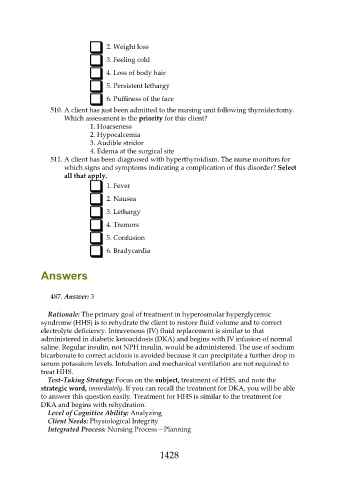Page 1428 - Saunders Comprehensive Review For NCLEX-RN
P. 1428
2. Weight loss
3. Feeling cold
4. Loss of body hair
5. Persistent lethargy
6. Puffiness of the face
510. A client has just been admitted to the nursing unit following thyroidectomy.
Which assessment is the priority for this client?
1. Hoarseness
2. Hypocalcemia
3. Audible stridor
4. Edema at the surgical site
511. A client has been diagnosed with hyperthyroidism. The nurse monitors for
which signs and symptoms indicating a complication of this disorder? Select
all that apply.
1. Fever
2. Nausea
3. Lethargy
4. Tremors
5. Confusion
6. Bradycardia
Answers
487. Answer: 3
Rationale: The primary goal of treatment in hyperosmolar hyperglycemic
syndrome (HHS) is to rehydrate the client to restore fluid volume and to correct
electrolyte deficiency. Intravenous (IV) fluid replacement is similar to that
administered in diabetic ketoacidosis (DKA) and begins with IV infusion of normal
saline. Regular insulin, not NPH insulin, would be administered. The use of sodium
bicarbonate to correct acidosis is avoided because it can precipitate a further drop in
serum potassium levels. Intubation and mechanical ventilation are not required to
treat HHS.
Test-Taking Strategy: Focus on the subject, treatment of HHS, and note the
strategic word, immediately. If you can recall the treatment for DKA, you will be able
to answer this question easily. Treatment for HHS is similar to the treatment for
DKA and begins with rehydration.
Level of Cognitive Ability: Analyzing
Client Needs: Physiological Integrity
Integrated Process: Nursing Process—Planning
1428

